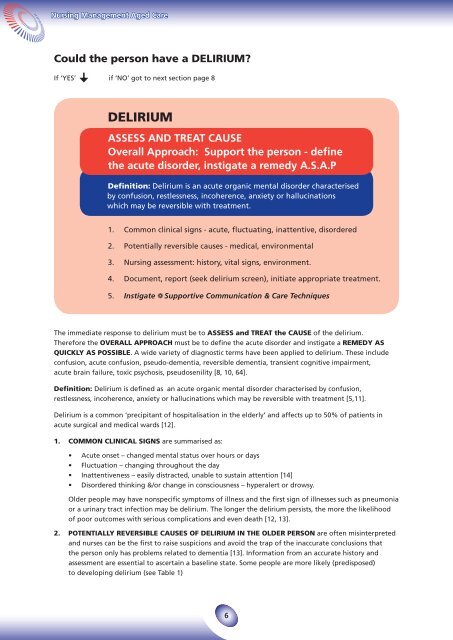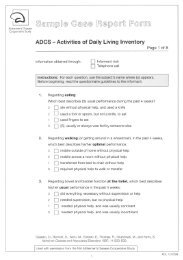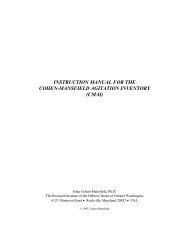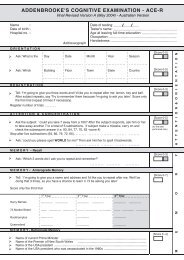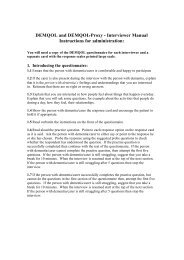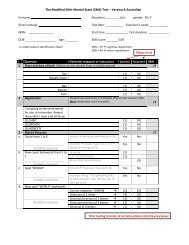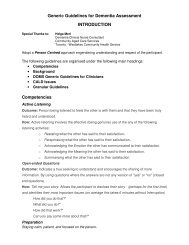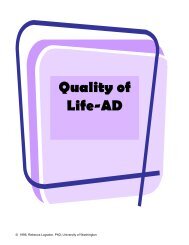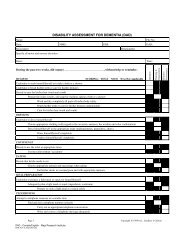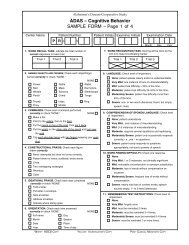Nursing Management of Disturbed Behaviour in Aged Care Facilities
Nursing Management of Disturbed Behaviour in Aged Care Facilities
Nursing Management of Disturbed Behaviour in Aged Care Facilities
Create successful ePaper yourself
Turn your PDF publications into a flip-book with our unique Google optimized e-Paper software.
<strong>Nurs<strong>in</strong>g</strong> <strong>Management</strong> <strong>Aged</strong> <strong>Care</strong><br />
Could the person have a DELIRIUM?<br />
If ‘YES’ if ‘NO’ got to next section page 8<br />
DELIRIUM<br />
ASSESS AND TREAT CAUSE<br />
Overall Approach: Support the person - def<strong>in</strong>e<br />
the acute disorder, <strong>in</strong>stigate a remedy A.S.A.P<br />
Def<strong>in</strong>ition: Delirium is an acute organic mental disorder characterised<br />
by confusion, restlessness, <strong>in</strong>coherence, anxiety or halluc<strong>in</strong>ations<br />
which may be reversible with treatment.<br />
1. Common cl<strong>in</strong>ical signs - acute, fluctuat<strong>in</strong>g, <strong>in</strong>attentive, disordered<br />
2. Potentially reversible causes - medical, environmental<br />
3. <strong>Nurs<strong>in</strong>g</strong> assessment: history, vital signs, environment.<br />
4. Document, report (seek delirium screen), <strong>in</strong>itiate appropriate treatment.<br />
5. Instigate a Supportive Communication & <strong>Care</strong> Techniques<br />
The immediate response to delirium must be to ASSESS and TREAT the CAUSE <strong>of</strong> the delirium.<br />
Therefore the OVERALL APPROACH must be to def<strong>in</strong>e the acute disorder and <strong>in</strong>stigate a REMEDY AS<br />
QUICKLY AS POSSIBLE. A wide variety <strong>of</strong> diagnostic terms have been applied to delirium. These <strong>in</strong>clude<br />
confusion, acute confusion, pseudo-dementia, reversible dementia, transient cognitive impairment,<br />
acute bra<strong>in</strong> failure, toxic psychosis, pseudosenility [8, 10, 64].<br />
Def<strong>in</strong>ition: Delirium is def<strong>in</strong>ed as an acute organic mental disorder characterised by confusion,<br />
restlessness, <strong>in</strong>coherence, anxiety or halluc<strong>in</strong>ations which may be reversible with treatment [5,11].<br />
Delirium is a common ‘precipitant <strong>of</strong> hospitalisation <strong>in</strong> the elderly’ and affects up to 50% <strong>of</strong> patients <strong>in</strong><br />
acute surgical and medical wards [12].<br />
1. COMMON CLINICAL SIGNS are summarised as:<br />
• Acute onset – changed mental status over hours or days<br />
• Fluctuation – chang<strong>in</strong>g throughout the day<br />
• Inattentiveness – easily distracted, unable to susta<strong>in</strong> attention [14]<br />
• Disordered th<strong>in</strong>k<strong>in</strong>g &/or change <strong>in</strong> consciousness – hyperalert or drowsy.<br />
Older people may have nonspecific symptoms <strong>of</strong> illness and the first sign <strong>of</strong> illnesses such as pneumonia<br />
or a ur<strong>in</strong>ary tract <strong>in</strong>fection may be delirium. The longer the delirium persists, the more the likelihood<br />
<strong>of</strong> poor outcomes with serious complications and even death [12, 13].<br />
2. POTENTIALLY REVERSIBLE CAUSES OF DELIRIUM IN THE OLDER PERSON are <strong>of</strong>ten mis<strong>in</strong>terpreted<br />
and nurses can be the first to raise suspicions and avoid the trap <strong>of</strong> the <strong>in</strong>accurate conclusions that<br />
the person only has problems related to dementia [13]. Information from an accurate history and<br />
assessment are essential to ascerta<strong>in</strong> a basel<strong>in</strong>e state. Some people are more likely (predisposed)<br />
to develop<strong>in</strong>g delirium (see Table 1)


